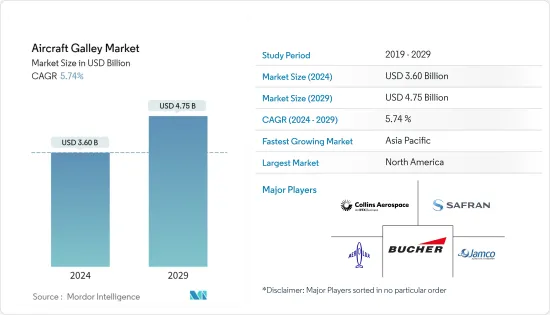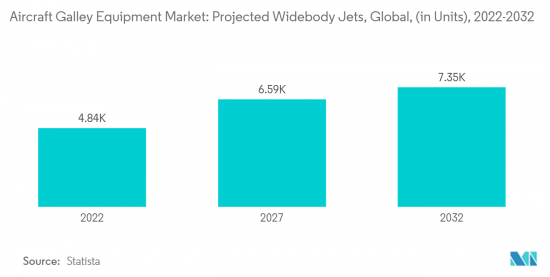
|
市場調査レポート
商品コード
1404565
航空機用ギャレー:市場シェア分析、産業動向・統計、成長予測、2024~2029年Aircraft Galley - Market Share Analysis, Industry Trends & Statistics, Growth Forecasts 2024 - 2029 |
||||||
カスタマイズ可能
適宜更新あり
|
|||||||
| 航空機用ギャレー:市場シェア分析、産業動向・統計、成長予測、2024~2029年 |
|
出版日: 2024年01月04日
発行: Mordor Intelligence
ページ情報: 英文 110 Pages
納期: 2~3営業日
|
全表示
- 概要
- 目次
航空機用ギャレー市場規模は2024年に36億米ドルと推定され、2029年には47億5,000万米ドルに達すると予測され、予測期間中(2024-2029年)のCAGRは5.74%で成長する見込みです。

航空機用ギャレーは、客室乗務員が乗客に提供するサービスを促進するために極めて重要です。航空機用ギャレーは、フライト中に機内の乗客に提供される食事の選択肢の多さという点で、航空会社のフライト体験を大幅に向上させます。乗客のニーズに対応し、機内サービスを提供し、航空機内のスペースを効率的に利用する必要性が、ギャレー採用の促進要因となっています。航空輸送が主要な輸送手段となったことで、機内食や飲料などの機内サービスの需要がギャレーの設置につながりました。航空会社は、これらの機内サービスを提供することが経済的に有益であり、乗客の満足度に貢献し、さらなる収益をもたらす可能性があることを認識しました。
格安航空会社(LCC)モデルは、限られたサービスを有料で提供する一方で、機内乗客数を増やすことに重点を置いています。LCCの世界の市場浸透が進むにつれ、航空機内のスペース制約に適応するための設計課題が生じ、厨房設計者は厨房機器の小型化・軽量化を余儀なくされています。技術および設計の複雑さは、航空機用ギャレー市場のメーカーにとって一定の課題となっています。データ分析や自動化を利用してケータリング業務を最適化するスマートギャレーソリューションの採用など、航空機用ギャレーには最先端技術が統合されています。特にこのような技術は、航空会社が在庫を効果的に管理し、食品廃棄を減らし、旅客体験を向上させるのに役立つ可能性があります。
航空機用ギャレー市場動向
双通路型航空機が予測期間で最も高いCAGRを記録
航空旅客輸送量の増加により、多くの航空会社が機体規模の拡大や既存の航空機の近代化を進めています。世界の航空旅客数の増加に伴い、長距離便の需要が増加しました。双通路型航空機は、このような長距離路線を効率的にカバーするように設計されており、より高い乗客定員と快適性を提供しています。また、ビジネスクラスやファーストクラスなどのプレミアムキャビンにも、広々としたレイアウトの双通路機が好まれ、航空会社は一流のサービスやアメニティを提供することができます。これらの航空機に設置されているギャレーは、乗客の幅広い食べ物や飲み物の好みに応えるために活用されています。そのため、最新のギャレーには、エスプレッソマシンやワインチラーインサートなど、豪華なタイプの設備がいくつか設置されています。航空会社は差別化されたサービスを市場での存在感とブランドイメージを高める手段と認識しているため、新世代の航空機の調達は航空機厨房の統合を促進し、それによって航空機厨房市場の事業見通しを押し上げると思われます。

予測期間中、アジア太平洋地域が最も高い需要を生み出す見込み
アジア太平洋地域の発展途上国における堅調な経済成長、良好な人口、人口動態が、同地域の航空旅客輸送を牽引しています。同地域では過去10年間に航空旅客輸送量が大幅に増加しましたが、その主な理由は同地域の観光地と航空旅行へのアクセスのしやすさにあり、予測期間中もこの傾向は続くと予想されます。ボーイングのCommercial Market Outlookによると、中国は2040年までに民間航空機納入総数の20%を占めるようになると予想されています。エアバスによれば、この地域の平均旅客数が前年比5.3%増であることから、2040年までに17,600機以上の新型航空機が必要となります。2027年までに、中国は航空輸送量で世界最大の航空市場になると予測され、インドは世界第3位の航空市場に発展すると予測され、インドネシアやタイなどの他の国々は世界市場のトップ10に入ると予測されています。このような良好な動向は、この地域における航空機用ギャレーの需要を促進すると予想されます。こうした予測は、航空機OEM各社が同地域での足跡を強化することに主眼を置くよう促しています。
航空機用ギャレー業界の概要
航空機用ギャレー市場は、世界レベルで事業を展開する支配的なベンダーが限られているため、半固体化しています。市場競争は激しく、各社が最大の市場シェアを獲得しようと競い合っています。航空機厨房の設計や重量に関連する制約や、マクロ経済的要因による航空機発注のキャンセルが市場の成長を阻害しています。ベンダーは、激しい市場競争の中で生き残るために、航空機OEMに高度なシステムを提供しなければならないです。市場を独占しているのは、Aerolux Ltd、JAMCO Corporation、Collins Aerospace(RTX Corporation)、Safran、Bucher Leichtbau AGなどです。これらのプレーヤーは主に、自社製造能力、世界な拠点網、製品提供、研究開発投資、強力な顧客基盤に基づいて競争しています。
その他の特典:
- エクセル形式の市場予測(ME)シート
- 3ヶ月間のアナリスト・サポート
目次
第1章 イントロダクション
- 調査の前提条件
- 調査範囲
第2章 調査手法
第3章 エグゼクティブサマリー
第4章 市場力学
- 市場概要
- 市場促進要因
- 市場抑制要因
- 業界の魅力度-ポーターのファイブフォース分析
- 買い手/消費者の交渉力
- 供給企業の交渉力
- 新規参入業者の脅威
- 代替品の脅威
- 競争企業間の敵対関係の強さ
第5章 市場セグメンテーション
- 航空機タイプ
- 単通路型
- 双通路型
- ビジネスジェット機
- 地域
- 北米
- 米国
- カナダ
- 欧州
- ドイツ
- 英国
- フランス
- スペイン
- その他欧州
- アジア太平洋
- 中国
- インド
- 日本
- 韓国
- その他アジア太平洋地域
- ラテンアメリカ
- メキシコ
- ブラジル
- その他ラテンアメリカ
- 中東・アフリカ
- アラブ首長国連邦
- サウジアラビア
- エジプト
- 南アフリカ
- その他中東・アフリカ
- 北米
第6章 競合情勢
- ベンダー市場シェア
- 企業プロファイル
- Aerolux Ltd.
- AVIC Cabin Systems Limited
- Collins Aerospace(RTX Corporation)
- Safran
- Bucher Leichtbau AG
- Diehl Stiftung & Co. KG
- Dynamo Aviation Inc.
- JAMCO Corporation
- Korita Aviation(Direct Aviation)
- Miller Fabrication & Welding, Inc.
- Turkish Airlines Technic Inc.
第7章 市場機会と今後の動向

The Aircraft Galley Market size is estimated at USD 3.60 billion in 2024, and is expected to reach USD 4.75 billion by 2029, growing at a CAGR of 5.74% during the forecast period (2024-2029).
An aircraft galley is crucial for facilitating the services offered to the passengers by the cabin crew. Aircraft galleys significantly enhance the airline's flight experience in terms of the plethora of meal options served to the onboard passengers during a flight. The need to keep up with passenger needs, provision of inflight services, and efficient use of space on aircraft is a driving factor for the adoption of galleys. The demand for onboard services such as meals and beverages has led to the installation of galleys as air transport became a major mode of transport. Airlines recognized that offering these onboard services would be economically beneficial, contributing to passenger satisfaction and potentially bringing additional revenues.
The low-cost carrier (LCC) model focuses on increasing the number of onboard passengers while providing limited services as pay-per-demand. The increasing global market penetration of LCCs has resulted in design challenges to adjust to space constraints inside an aircraft, forcing the galley designers to reduce the size and weight of the galley equipment. Technological and design complexity are certain challenges for the manufacturers of the aircraft galley market. The integration of cutting-edge technology in aircraft galleys, such as the adoption of smart galley solutions that use data analytics and automation to optimize catering operations. In particular, such technologies may help airlines manage their inventories effectively, reduce food waste, and enhance the passenger experience.
Aircraft Galley Market Trends
Twin-Aisle Aircraft to Register the Highest CAGR in the Forecast Period
This heightened air passenger traffic prompted numerous airlines to expand their fleet sizes and modernize their existing aircraft. With the increased global air passenger traffic, the demand for long-haul flights increased. Twin-aisle aircraft are designed to cover these extended routes efficiently, offering higher passenger capacity and comfort. Twin-aisle aircraft are also preferred for premium cabins, such as business and first class, due to their spacious layouts, allowing airlines to provide top-notch services and amenities. Galleys installed onboard these aircraft are utilized to cater to the passengers' wide range of food and drink preferences. Hence, the inserts of a modern galley include several luxurious types of equipment, such as espresso machines and wine chiller inserts. Since airlines perceive differentiated service as a means to enhance their market presence and brand image, the procurement of new-generation aircraft would drive the integration of aircraft galleys, thereby driving the business prospects of the aircraft galley market. For instance, in 2022, Boeing received 213 orders for widebodies. In June 2023, Air India ordered 70 widebody planes, comprising 34 A350-1000s and six A350-900s from Airbus, 20 B787 Dreamliners, and 10 B777Xs from Boeing. These scheduled orders are anticipated to bolster the growth of aircraft galley in twin-aisle aircraft.

Asia-Pacific is Expected to Generate the Highest Demand During the Forecast Period
The robust economic growth, favorable population, and demographic profiles of the populace in developing countries in the Asia-Pacific region are driving the air passenger traffic in the region. The region has seen a significant increase in air passenger traffic during the past decade, mostly due to the tourist destinations in the region and the ease of access to air travel, which is expected to continue during the forecast period. According to Boeing Commercial Market Outlook, China is expected to account for 20% of the total commercial aircraft deliveries by 2040. As per Airbus, the region will require more than 17,600 new aircraft by 2040, given the average 5.3% YoY passenger growth in the region. By 2027, China is forecasted to become the world's largest aviation market in terms of air traffic, and India is forecasted to develop into the world's third-largest aviation market, while other countries, such as Indonesia and Thailand, are forecasted to enter the top 10 global markets. Such favorable trends are anticipated to drive the demand for aircraft galleys in the region. These projections have encouraged aircraft OEMs to primarily focus on enhancing their footprint in the region. For instance, Embraer has planned to increase its aircraft deliveries to 100 per year due to an increase in orders from China and India. The company laid out the groundwork to deliver planes to China, as in November 2022, Embraer's E2 series, the E190-E2 commercial jets, received design certification approval from the Chinese Authorities.
Aircraft Galley Industry Overview
The aircraft galley market is semi-consolidated due to the presence of a limited number of dominant vendors operating at a global level. The market is highly competitive, with players competing to gain the largest market share. Constraints associated with the design and weight of aircraft galley and cancellation of aircraft orders due to macroeconomic factors impede the growth of the market. Vendors must provide advanced systems to aircraft OEMs to survive in an intensely competitive market environment. The dominant market players include Aerolux Ltd, JAMCO Corporation, Collins Aerospace (RTX Corporation), Safran, and Bucher Leichtbau AG. These players mainly compete based on their in-house manufacturing capabilities, global footprint network, product offerings, R&D investments, and strong client base. For instance, In August 2021, Safran launched the MaxFlex galley for the Boeing 737 family. MaxFlex galley provides maximum flexibility, infinite combinations, and easy maintenance. More than 2,000 MaxFlex galleys are installed in the aircraft. Safran also offers SpaceFlex V2 Galley for Airbus A320/A321 aircraft. This galley maximizes an aircraft's floor space and opens an area for additional seats. The competitive environment is likely to intensify further due to an increase in product/service extensions and technological innovations. For instance, in June 2023, Collins Aerospace (RTX Corporation) launched a diagnostic tool for problems in aircraft galleys. The diagnostic tool provides the data required to identify unit faults, which will lead to reduced time in troubleshooting and reduced the occurrence of misdiagnosing unit malfunctions.
Additional Benefits:
- The market estimate (ME) sheet in Excel format
- 3 months of analyst support
TABLE OF CONTENTS
1 INTRODUCTION
- 1.1 Study Assumptions
- 1.2 Scope of the Study
2 RESEARCH METHODOLOGY
3 EXECUTIVE SUMMARY
4 MARKET DYNAMICS
- 4.1 Market Overview
- 4.2 Market Drivers
- 4.3 Market Restraints
- 4.4 Industry Attractiveness - Porter's Five Forces Analysis
- 4.4.1 Bargaining Power of Buyers/Consumers
- 4.4.2 Bargaining Power of Suppliers
- 4.4.3 Threat of New Entrants
- 4.4.4 Threat of Substitute Products
- 4.4.5 Intensity of Competitive Rivalry
5 MARKET SEGMENTATION
- 5.1 Aircraft Type
- 5.1.1 Single-aisle
- 5.1.2 Twin-aisle
- 5.1.3 Business Jets
- 5.2 Geography
- 5.2.1 North America
- 5.2.1.1 United States
- 5.2.1.2 Canada
- 5.2.2 Europe
- 5.2.2.1 Germany
- 5.2.2.2 United Kingdom
- 5.2.2.3 France
- 5.2.2.4 Spain
- 5.2.2.5 Rest of Europe
- 5.2.3 Asia-Pacific
- 5.2.3.1 China
- 5.2.3.2 India
- 5.2.3.3 Japan
- 5.2.3.4 South Korea
- 5.2.3.5 Rest of Asia-Pacific
- 5.2.4 Latin America
- 5.2.4.1 Mexico
- 5.2.4.2 Brazil
- 5.2.4.3 Rest of Latin America
- 5.2.5 Middle East and Africa
- 5.2.5.1 United Arab Emirates
- 5.2.5.2 Saudi Arabia
- 5.2.5.3 Egypt
- 5.2.5.4 South Africa
- 5.2.5.5 Rest of Middle East and Africa
- 5.2.1 North America
6 COMPETITIVE LANDSCAPE
- 6.1 Vendor Market Share
- 6.2 Company Profiles
- 6.2.1 Aerolux Ltd.
- 6.2.2 AVIC Cabin Systems Limited
- 6.2.3 Collins Aerospace (RTX Corporation)
- 6.2.4 Safran
- 6.2.5 Bucher Leichtbau AG
- 6.2.6 Diehl Stiftung & Co. KG
- 6.2.7 Dynamo Aviation Inc.
- 6.2.8 JAMCO Corporation
- 6.2.9 Korita Aviation (Direct Aviation)
- 6.2.10 Miller Fabrication & Welding, Inc.
- 6.2.11 Turkish Airlines Technic Inc.


